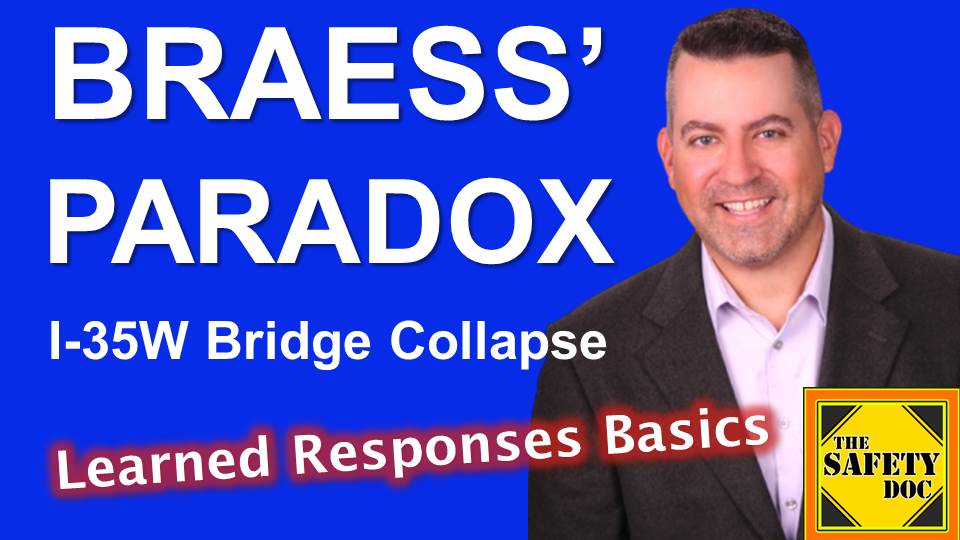The Braess Paradox | Psychological Impact of I35W Bridge Collapse on Driving Behavior | SDP169
[Podcast] WHAT IS THE BRAESS PARADOX? Braess’ Paradox states that, counterintuitively, adding a road to a road network can slow down overall traffic through it. The paradox was discovered in 1968 by German mathematician Dietrich Braess as he examined humans driving behavior. At the root of this paradox is that every driver thinks for themselves as the lack of cooperation with other drivers means that every driver will aim to take the fastest possible route. Hence, the shortest route becomes overwhelmed and also slows down merging-in from lesser-traveled nodes, which, in turn, causes delays on those nodes. In New York, Boston, London, and Seoul, traffic congestion decreased in as little as a week after congested roadways were closed.

DIRECT LINK to MP3 of this Episode: https://tinyurl.com/SDP169-AUDIO
HUMAN VS. ANT. “According to scientists who studied traffic density for humans and for ants, it was discovered that when the occupancy rate on the road exceeds 40 percent, people gradually slow down their speed and stop after a certain stage. Thus, congested traffic or traffic jams. In ants, on the other hand, we observe an opposite phenomenon. As the traffic density increases, the flow increases at the same time. When the occupancy rate on the road reaches 80 percent, the ants synchronize their tempo and continue on their path at the most optimal speed (SOURCE: Ibrahim Kovin, Oct 18, 2021. Cantorsparadise.com). It might be argued that the ants’ goal is survival of the colony and the human’s goal is to be the first person at work. So we expect people to flock to the shortest possible route, or our navigation apps pull from the same maps and data to funnel us into a bogged down shortcut. AI can sell us out, but the antecedent event can also steer our subconscious thinking.
FORCED LEARNED BEHAVIOR. When people are forced to alter their routines due to an unexpected, dramatic event – such as a bridge failure, they tend to begrudgingly follow government-placed detour signs and also poke around for a new path that allows them to complete their commute. As their long-accustomed-to primary route is out of service, drivers tend to stick with their first-experienced new routes – even if they are not particularly efficient. They would rather travel a known route than attempt to find a shorter route. One would think this new patterning would be readily tossed aside if the previous route, which was shorter and faster, was restored. That’s what happens during expected closures of familiar routes. However, when the I35W bridge was re-opened in 2008, demand did not bounce back to pre-collapse levels as expected – and the addition of lanes didn’t cause the dreaded Braess’ Paradox.
THREE REASONS DRIVERS DIDN’T REVERT TO FASTER PRE-COLLAPSE ROUTES. These three facts might have influenced drivers’ behavior: (1) The unexpectedness of the I-35W Bridge collapse and the mandatory route changes some commuters were forced to make created inherent resistance to return the bridge following reopening; (2) The prolonged closure was lengthy enough for the benefits of route familiarity in the disrupted network to outweigh the low travel times found on the new bridge; and (3) The tragedy itself discouraged some commuters from returning to the site (SOURCE: MN DOT Research Services. Traffic Flow and Road User Impacts of the Collapse of the I-35W Bridge over the Mississippi River. David Levinson, Principal Investigator).
SUMMARY. Three take-away points. (1) Humans tend to think individually and gravitate to the shortest or fastest path, often overloading it. This behavior has been observed with new roads as well as drive-thru lines at restaurants. The phenomenon is known as Braess’ Paradox. (2) Following an unexpected disruption, an avoidance phenomenon is observed that will typically diminish over time. (3) And, in contrast, pre-planned disruptions, even with similar magnitude, generate much smaller impacts. Bonus tip. In a crisis, think the opposite of the masses.
ACCORDING TO THE JOKER: “I just did what I do best. I took your little plan and I turned it on itself. Look what I did to this city with a few drums of gas and a couple of bullets. Hmmm? You know… You know what I’ve noticed? Nobody panics when things go “according to plan.” Even if the plan is horrifying! If, tomorrow, I tell the press that, like, a gang banger will get shot, or a truckload of soldiers will be blown up, nobody panics, because it’s all “part of the plan”. But when I say that one little old mayor will die, well then everyone loses their minds. Introduce a little anarchy. Upset the established order, and everything becomes chaos. I’m an agent of chaos. Oh, and you know the thing about chaos? It’s fair!” (quotation from Heath Ledger as The Joker in Christopher Nolan movie, The Dark Knight).
This is episode 169 of The Safety Doc Podcast published on 02-08-2022.
FOLLOW
- Watch this episode on “The Safety Doc” YouTube channel https://tinyurl.com/SDP169-VIDEO
- Listen to this episode on PodBean MP3 https://tinyurl.com/SDP169-AUDIO
- Apple Podcasts http://tinyurl.com/SafetyDocApplePodcasts
- SAFETY DOC WEBSITE & BLOG safetyphd.com
- Follow David & The Safety Doc Podcast on Twitter @SafetyPhD
- Email Dr. Perrodin thesafetydoc@gmail.com
Purchase Dr. Perrodin’s books
School of Errors – Rethinking School Safety in America
The Velocity of Information – Human Thinking During Chaotic Times
